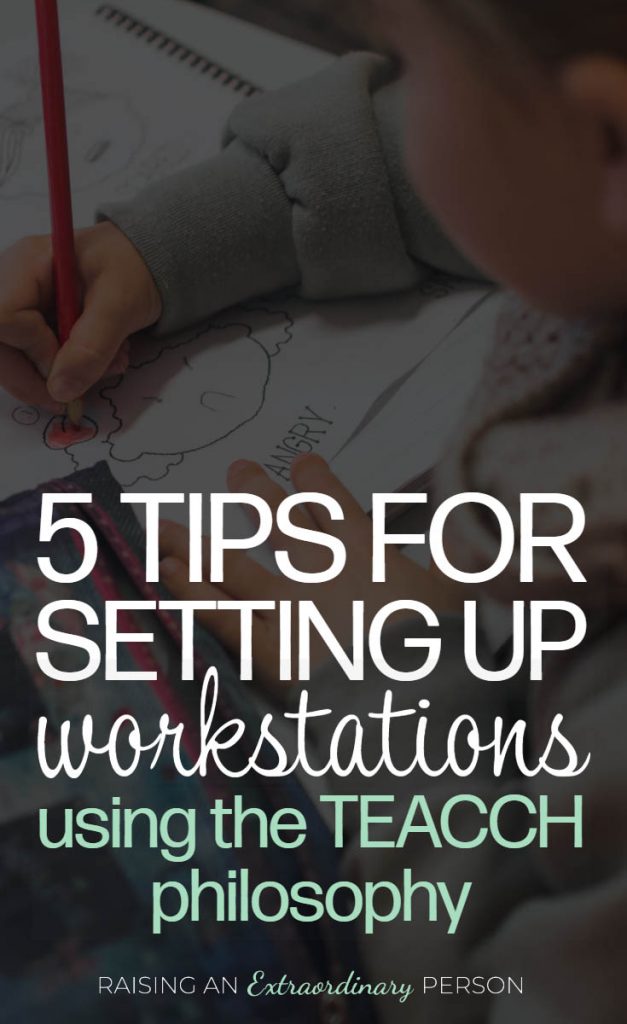How to Set Up Learning Stations at Home Following The TEACCH Philosophy
As a parent, you have a significant amount of power when it comes to influencing your child’s education and helping them flourish.
This power comes from the strength and quality of the relationship you have with your child.
How to Set Up Learning Stations at Home – The TEACCH Philosophy
Disclaimer: This post contains affiliate links.
This post is part of a 13 part series. Each post in the series will explain an evidence-based strategy used by professionals for managing behavior with children on the autism spectrum. Each part of this series will contain a table of contents so you can easily navigate to the different strategies.
Table of Contents:
- Introduction
- Build a Relationship
- Individualize Motivation
- Observe, Listen, then Join
- Optimize Language
- The Premack Principal
- Basic Redirect
- Breaks
- Picture Rehearsal
- Add Structure at Home
- Teach Independence with Prompting
- Transactional Supports
- Add Structure to the Learning Environment
This strategy about how to structure learning is based on the TEACCH program (which is a program used at schools all over the country). This program was developed to help students with limited interests who struggle to follow adult-directed routines to be successful.
The TEACCH philosophy focuses on the individual’s strengths to enable the development of independence and supports weaknesses to enable maximum success and reduce stress.
Why Structured Learning Works
Structuring learning based on the TEACCH program is highly successful for six key reasons.
Use of TEACCH Philosophy in Schools
Independent Work Stations
“Workstations” are commonly used in schools as part of TEACCH.
Effective workstations include structure, routine, and visual cues while limiting distractions in order to promote independence, organization skills, and the concepts of working in an ordered manner.
After tasks are taught by a teacher and mastered by the student, they can be used in independent work stations.
A good workstation will show your child:
The Workstation activities will:
Example:

Setting Up Workstations Using the TEACCH Philosophy
1. Pace Tasks At Child’s Level
Often, kids with autism need more time to process new information than their typically developing peers.
Children should be provided with extra time to complete tasks and should also be given extra time between instruction and expected response, to help ensure their success.
2. Provide Concrete Examples
Children learn kinesthetically. In other words, they learn best by seeing and doing.
All oral instructions should be supplemented with concrete, visual examples. For example, in
At home, for example – if you instruct your child to clean their bedroom, also show them a photo(s) of their bedroom when it’s clean.
3. Introduce New Tasks in a Familiar Environment
Does your child seem to resist trying new activities or learning new skills? Whenever introducing something new to your child, it’s helpful to do it in a familiar environment first (such as at home), before getting them to use that skill under other circumstances or in other environments.
4. Plan for Transitions
Transitions should be carefully and thoughtfully planned. Whether your child is moving between classrooms at school or different areas in the same room, or from home to daycare, daycare to school, and even from one task to the next within a workstation, it is a good idea to prepare the child in advance of the change.
It is also important to prepare any people who may be receiving the child – another parent, caregiver, teacher, etc.
All caregivers need to be on the same page and consistent with your child.
5. Use Consistent Cues to Signal Your Child
When the same cues are used consistently and repeatedly with your child, it’s easier for them to learn and follow a routine, and anticipate upcoming activities.
For example, playing the same song before
Check out the 10 best preschool transition songs here.
Another great option for older children is to use a gong or triangle. When you hit the gong, everyone should stop what they’re doing and listen quietly. When they can no longer hear it, it’s time to move on to the next activity.

Best Practices for Structuring Learning at Home
When you’re using the TEACHH approach at home there are a few best practices to consider. Following these best practices will ensure the greatest chance of success for your child to practice working independently at home.
This setup is ideal for both homeschooling parents and for those who want to reinforce learning concepts from school.
Creating Workstations At Home:
Workstation Layout

Recommended Products:
These are just a few items I recommend if you’re creating a workstation at home for your child.
It’s ideal to use a laminator and dry erase markers because your child will complete the same activities multiple times as practice and this will save significantly on paper.
I love the dry erase markers below just because there’s such a large variety of colors.
You can use the velcro pieces with a variety of visuals so they can be re-used again and again.
Free Printable TEACCH Tasks
These are just a few free resources I found that you can print and start using right away. There are lots of other resources out there, and once you’re comfortable, you can also make your own.
- I can count task cards
- Letter worksheets (includes printing practice and upper/lower case matching)
- Color and shape sorting
- Big and small sorting
- Addition game (up to 25)
- Number matching practice
- Telling time
- Vocabulary word matches: Macaroni/French fries, hamburger/cereal, pizza/popcorn, eggs/hotdogs
Blank template to create your own matching tasks

